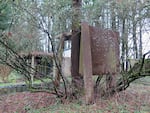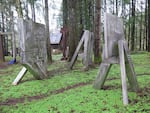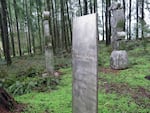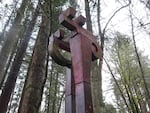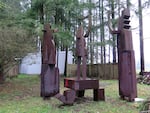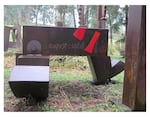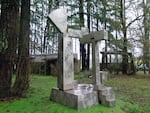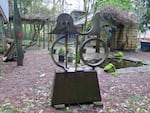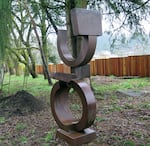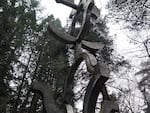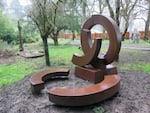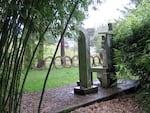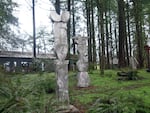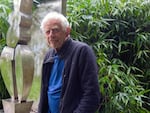
Sculpture artist Lee Kelly in his Oregon City studio and garden.
April Baer / OPB
The massive sculptures of Lee Kelly are part of the fabric of Oregon. From the towering "Bend Gate," the hieroglyphic forms of "Memory 99" in Portland’s Northwest park blocks, the steel lattice of "Akbar’s Garden" in the University of Oregon, or the whimsical "Akbar’s Elephant," newly placed in the lobby of Portland's Fox Tower.
Across the decades, the strong, confident lines of his design aesthetic have married carefully balanced curves and planes in ways that are sometimes as familiar as the Cascades, and sometimes carrying the promise of faraway places that most of us only imagine.
At 84, the artist, teacher and trekker Lee Kelly is still keeping up a remarkable pace. For 60 years Kelly has worked primarily at a studio on the site of a lush, five-acre 1920s dairy farm in Oregon City. Kelly and his late wife, the artist Bonnie Bronson, purchased the farm in the early '60s, transforming it into a workplace and sculpture garden.

"Secesh", Lee Kelly, 1976-1978, corten steel.
April Baer / OPB
Here are a few highlights from our conversation with Kelly at his studio.
Q&A with Lee Kelly
April Baer: This place where we’re standing used to be an old dairy farm. What did this look like when you and Bonnie first came here?
Lee Kelly: It was open fields. And the buildings ... it was right after the Columbus Day storm, so the buildings that were here were badly damaged.
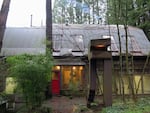
The half-dozen structures comprising Kelly's studio comprise his personal studio, and residence space administrated by Pacific Northwest College of Art.
April Baer / OPB
Baer: Did you have an idea of what it could look like?
Kelly: Almost immediately we came up with a game of trying to put one little piece back together from what it might have been or should have been. So we began to garden and plant trees.
Baer: How much did she get to see of this growth?
Kelly: She got a lot of it.
Baer: I wanted to ask you about the "Bonnie Quartet" [works made in memory of Bonnie Bronson, who died in a Mt Adams climbing accident in 1990].
Kelly: Four pieces, they're all labeled from places Bonnie and I visited that prior year. So there are names of sites … I think in Copán, a couple of Idaho places. I think, with this sculpture, I really did come to grips with grieving. And a way to move on. It wasn't a smooth process. There was issues of finding my own crevasse in the middle of all that.
Baer: Three of these forms are among your taller structures. Standing next to it, I can’t help but feel dwarfed by grief.
Kelly: OK, that's pretty good. I had never thought of it that way. But they are kind of figurative. Standing there, waving arms or something. Also, the little climbing holds on the sides, Bonnie was a wonderful rock climber and I made those things so they could be climbed.
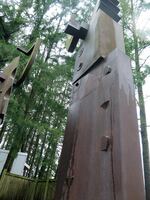
"Bonnie Quartet", Lee Kelly, 1990-1991, corten steel, detail.
April Baer / OPB
Baer: You were born in central Idaho and grew up ranching there. What kind of experience was that for somebody who would spend his adult life shaping these massive works of metal?
Kelly: I think the ranch life, growing up, had a huge impact — the ranch and the canyon on a big river. We did everything with a team of horses. I can remember when the road was built. Part of the reason I never went east was that I could not leave the West.
Baer: Those are the kind of landscapes in which a person can really lose himself. How did they make you feel?
Kelly: I felt very much a part of it.
Baer: The sense of scale? It didn’t feel belittling?
Kelly: No, I think you can become a part of a landscape without being diminished by it. I think climbing lets you have that feeling. You're never going to dominate a mountain. The mountain has its own rules and it'll shrug you off in an instant. But I don't think you should be intimidated by it.
Baer: How do you see the relationship between a sculptural work and the space that it occupies?
Kelly: A huge amount of change can happen just by moving it a few inches. If you move it a few miles or take it from a woodsy environment to the hard surface of a town, it changes the piece completely.
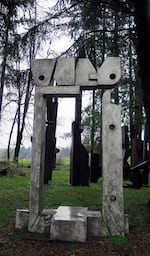
"Phi Mai", Lee Kelly, 1995, stainless steel. Years of travel, particularly in Asia, sparked Kelly's imagination, for architectural forms or ideas born from mythic themes.
April Baer / OPB
Baer: Is that something you spend a lot of time thinking about when you’re envisioning a design?
Kelly: No, you would just be totally distraught if you tried to imagine that many variables that could happen. You just do what you're going to do and live with the result.
Baer: What does it mean to complete them in a way that lets people interact with the work?
Kelly: I don't think you can prejudge the viewer. I think you do your best and you just hope it'll connect with someone. But I don't think you can think ahead of time about how it's going to be received. You have to do your best work. And sort of the viewer-be-damned in some ways. But often enough, what you feel about something will connect with somebody else. And they may not get the same thing you got out of it, but they may find something else that's meaningful.
